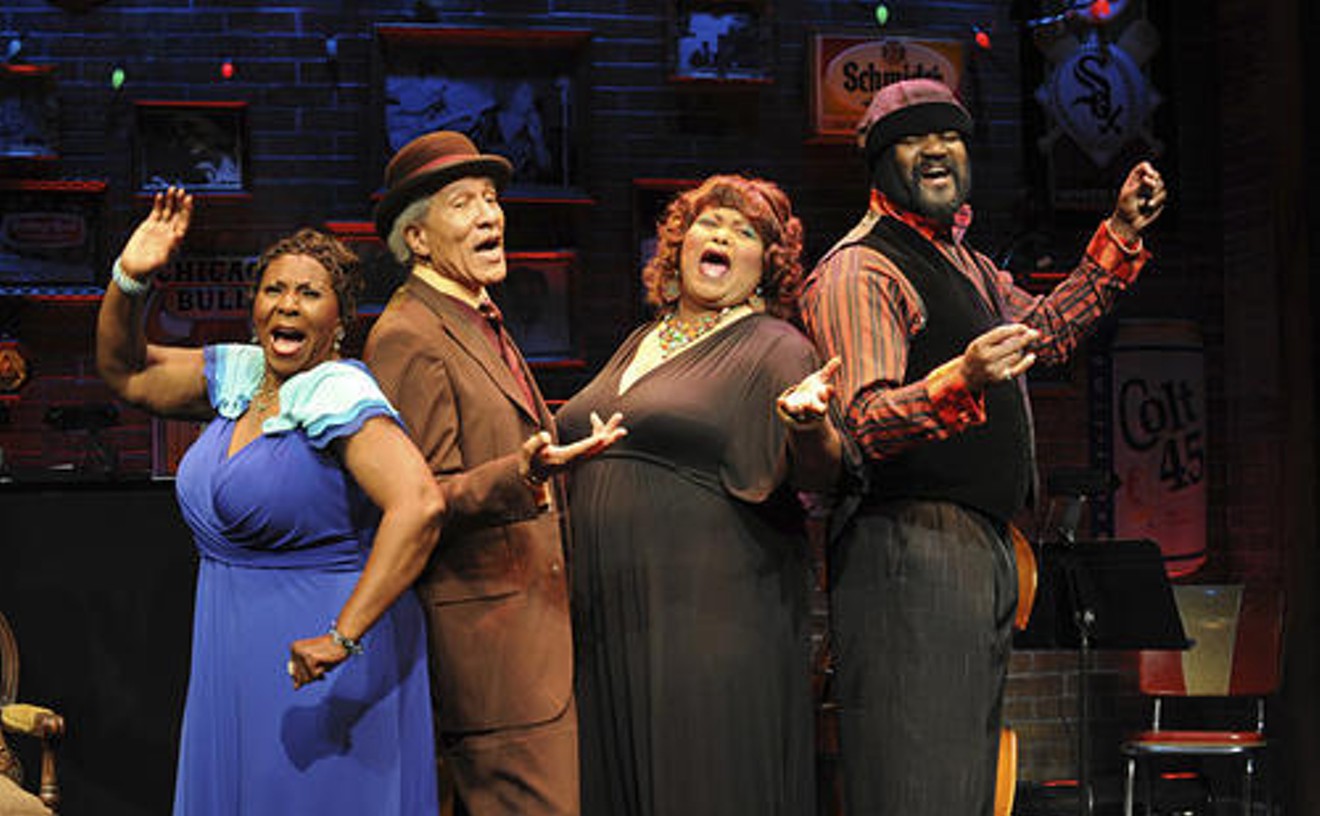Best Movie Theater
Gateway Cinema 4
Twenty-four movies at the multiplex and nothing to see. That's the sad reality of moviegoing in most of Broward and Palm Beach counties. The multiplexes continue to amaze us with the sheer quantity of utterly banal schlock they screen each week. (On exactly how many screens can you show Enemy of the State, to take one example, and still make money?) Shadowood 16 in Boca Raton, the Carefree Theatre in West Palm Beach, and Sunrise 8 in Fort Lauderdale occasionally break through the tedium, screening rarely seen independent films such as Central Station in recent months. But the most consistent venue for catching provocative, intelligent movies is the Gateway Cinema. The almost-50-year-old Fort Lauderdale landmark has over time transformed itself into a redoubtable art-house theater. One could see the restored version of Orson Welles' B-movie thriller Touch of Evil, as well as the luminous Giulietta Masina in Fellini's Nights of Cabiria, not to mention stellar contemporary films, such as Little Voice and Happiness, that did not really interest the multiplexes.
Best Movie Theater
Gateway Cinema 4
Twenty-four movies at the multiplex and nothing to see. That's the sad reality of moviegoing in most of Broward and Palm Beach counties. The multiplexes continue to amaze us with the sheer quantity of utterly banal schlock they screen each week. (On exactly how many screens can you show Enemy of the State, to take one example, and still make money?) Shadowood 16 in Boca Raton, the Carefree Theatre in West Palm Beach, and Sunrise 8 in Fort Lauderdale occasionally break through the tedium, screening rarely seen independent films such as Central Station in recent months. But the most consistent venue for catching provocative, intelligent movies is the Gateway Cinema. The almost-50-year-old Fort Lauderdale landmark has over time transformed itself into a redoubtable art-house theater. One could see the restored version of Orson Welles' B-movie thriller Touch of Evil, as well as the luminous Giulietta Masina in Fellini's Nights of Cabiria, not to mention stellar contemporary films, such as Little Voice and Happiness, that did not really interest the multiplexes.
Best Theater For Plays
Florida Stage

Every theater is saddled with the same basic challenge -- figuring out what audiences want. At Florida Stage, founder and producing director Louis Tyrrell isn't looking over his shoulder to see what others are doing. Nor is he serving up crowd pleasers just to sell tickets. Instead he's leading the way with challenging programming that you can't see anywhere else. In the past year, Florida Stage presented effervescent productions of three Florida premieres (with one more on the way this spring). Last summer the theater produced Michael McKeever's provocative new play, The Garden of Hannah List, as well as a Cole Porter revue that really was the tops. Not everything the theater presents is an unqualified success, but its willingness to take chances is.
- 262 S. Ocean Blvd., Lake Worth, 33462 Map
- 561-585-3433
- www.floridastage.org
Best Theater For Plays
Florida Stage
Every theater is saddled with the same basic challenge -- figuring out what audiences want. At Florida Stage, founder and producing director Louis Tyrrell isn't looking over his shoulder to see what others are doing. Nor is he serving up crowd pleasers just to sell tickets. Instead he's leading the way with challenging programming that you can't see anywhere else. In the past year, Florida Stage presented effervescent productions of three Florida premieres (with one more on the way this spring). Last summer the theater produced Michael McKeever's provocative new play, The Garden of Hannah List, as well as a Cole Porter revue that really was the tops. Not everything the theater presents is an unqualified success, but its willingness to take chances is.
Best Local Jazz Artist
Ira Sullivan
Sullivan is the best jazz artist in South Florida. No, you won't find him performing regularly in the area's so-called "jazz" rooms, nor will you be overly impressed with his recent recordings. Ira is not the best for what he's currently doing, he is the best because he is the very embodiment of jazz, that strangely dichotomous ethic that values ancient traditions while simultaneously ripping them apart. As adept on reeds as he is on brass, this trumpeter-saxophonist was at one time slated to join Charlie Parker's band, but Bird passed on before Ira could join him on the stand. This rarefied connection continued in Ira's long-time partnership with Parker sideman Red Rodney. Sullivan's greatest contribution to the South Florida jazz scene has been his overall influence on the region's best contemporary players. In the late '60s and throughout the '70s, Ira led groundbreaking ensembles featuring such young turks as Jaco Pastorius and was by all accounts a strict taskmaster who inculcated them with the true essence of jazz. Those he mentored are our best players today, and they claim Ira is the best.
Best Local Jazz Artist
Ira Sullivan
Sullivan is the best jazz artist in South Florida. No, you won't find him performing regularly in the area's so-called "jazz" rooms, nor will you be overly impressed with his recent recordings. Ira is not the best for what he's currently doing, he is the best because he is the very embodiment of jazz, that strangely dichotomous ethic that values ancient traditions while simultaneously ripping them apart. As adept on reeds as he is on brass, this trumpeter-saxophonist was at one time slated to join Charlie Parker's band, but Bird passed on before Ira could join him on the stand. This rarefied connection continued in Ira's long-time partnership with Parker sideman Red Rodney. Sullivan's greatest contribution to the South Florida jazz scene has been his overall influence on the region's best contemporary players. In the late '60s and throughout the '70s, Ira led groundbreaking ensembles featuring such young turks as Jaco Pastorius and was by all accounts a strict taskmaster who inculcated them with the true essence of jazz. Those he mentored are our best players today, and they claim Ira is the best.
Best Local Rock Band
Crease
With local radio powerhouse Zeta putting Crease's single, "Frustration," in heavy rotation and the band's five-song CD, Six-Pack Shy of Pretty, selling like cheap drugs, it's doubtful that you haven't heard our local rock heroes yet. In an area parched for rock 'n' roll and hungry for noise, Crease is the new crack for rock aficionados. With its postgrunge, 100 percent rock, punk-metal hybrid, Crease fills the void for fist-pumping middle-aged rockers reliving their glory days and angst-ridden teens alike. With major labels tentatively scoping Crease's unit-moving potential, locals should stake their claim to the band quickly before the rest of the nation does.
Best Local Rock Band
Crease
With local radio powerhouse Zeta putting Crease's single, "Frustration," in heavy rotation and the band's five-song CD, Six-Pack Shy of Pretty, selling like cheap drugs, it's doubtful that you haven't heard our local rock heroes yet. In an area parched for rock 'n' roll and hungry for noise, Crease is the new crack for rock aficionados. With its postgrunge, 100 percent rock, punk-metal hybrid, Crease fills the void for fist-pumping middle-aged rockers reliving their glory days and angst-ridden teens alike. With major labels tentatively scoping Crease's unit-moving potential, locals should stake their claim to the band quickly before the rest of the nation does.
Best Artistic Director
Rafael de Acha
He may not have presented the most provocative play or even the strongest season this year, but New Theatre's Rafael de Acha made his mark on the South Florida theater scene by continuing to put a personal vision into his productions. In the last year, the artistic director presented eight new plays and one stunningly original double bill of familiar works (Don Juan in Hell and A Christmas Carol). He assembled numerous combinations of actors in crackerjack casts. He spearheaded a campaign, still ongoing, to expand the theater beyond its tiny 78-seat black box. But most impressive of all, de Acha -- who designs and directs many New Theatre shows -- brings such intricate care and subtle intelligence to the details of design and staging that a de Acha production, recognizable anywhere, has come to be one of the high points on the South Florida cultural landscape.
Best Artistic Director
Rafael de Acha
He may not have presented the most provocative play or even the strongest season this year, but New Theatre's Rafael de Acha made his mark on the South Florida theater scene by continuing to put a personal vision into his productions. In the last year, the artistic director presented eight new plays and one stunningly original double bill of familiar works (Don Juan in Hell and A Christmas Carol). He assembled numerous combinations of actors in crackerjack casts. He spearheaded a campaign, still ongoing, to expand the theater beyond its tiny 78-seat black box. But most impressive of all, de Acha -- who designs and directs many New Theatre shows -- brings such intricate care and subtle intelligence to the details of design and staging that a de Acha production, recognizable anywhere, has come to be one of the high points on the South Florida cultural landscape.





